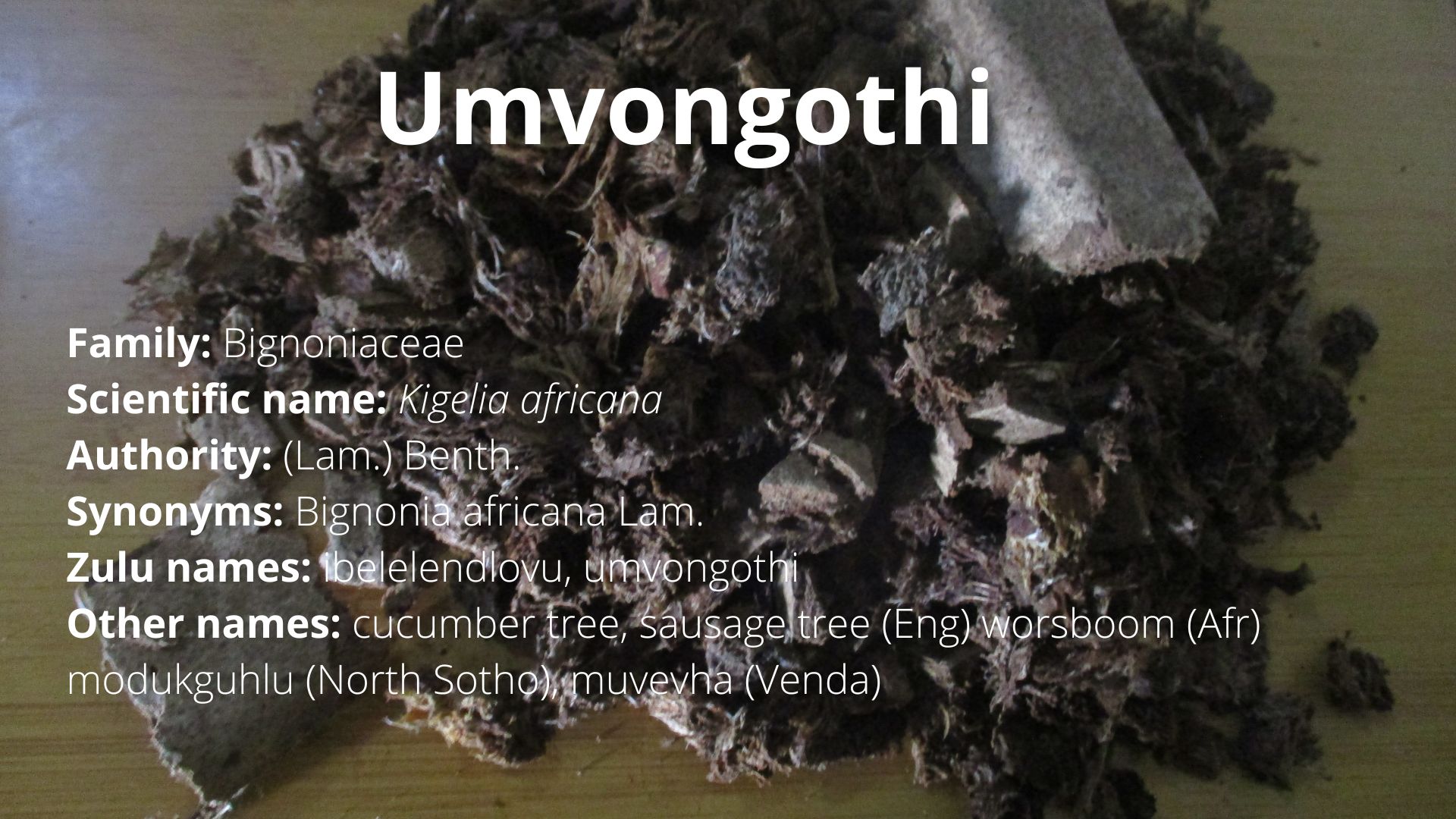Family: Bignoniaceae
Scientific name: Kigelia africana
Authority: (Lam.) Benth.
Synonym: Bignonia africana Lam.
Zulu names: ibelelendlovu, umvongothi
Other names: cucumber tree, sausage tree (English) worsboom (Afrikaans) modukguhlu (North Sotho), muvevha (Venda)
Description: K. africana is a fast growing medium-sized tree that grows in the tropical regions of Africa. It has a rounded crown, thick trunk, alternate pinnate leaves with three to six opposite pairs of leaflets, greenish-yellow and purplish-red bell-shaped five-merous flowers, and indehiscent woody fruits shaped like a sausage, containing obovoid seeds.
The fruit is never consumed fresh, because they are said to be toxic, especially when young. It may have purgative effects and cause blistering in the tongue and skin.
Medical properties
The plant reportedly has pharmacological properties, such as analgesic, anti-bacterial, anti-cancer, anti-diarrhoea, anti-inflammatory, anti-leprotic, anti-malarial, anti-microbial, anti-viral, anti–ulcer, and antioxidant activities as well as stimulant effect on the central nervous system.
Uses
- The fruit is used to treat acne and beautify the skin.
- The fruit is dried, powdered, and used for dressing wounds, sores, and ulcers.
- The fruit and bark are used in the brewing process to help fermentation and enhance the flavour of traditional beer.
- The fruit and bark are used to promote breast development in young women.
- The fruit is used for penis enlargement.
- The seeds are roasted and eaten as food.
- The powdered fruit and bark is used to treat sexually transmitted diseases, such as gonorrhoea and syphilis.
- The powdered fruit is used to treat rheumatism.
- The bark and fruits are used to treat ringworms and tapeworms.
- The bark and fruits are used for cicatrisation of new surgical incisions.
- The roots are used to produce a yellow dye.
- The bark is used to treat gynaecological and obstetrics ailments.
- The plant is used to treat swollen testicles.
- The plant is used as purgatives.
- The plant is used to protect against unclean spirits.
- The plant (fruit) is used as a charm for prosperity, to increase crop yields, and to impart strength and courage.
- The plant is a striking ornamental tree.
- The wood is used for dugout canoes, fence posts, planks, making boxes, drums, stools, yokes, tool handles, mortars, and utensils.
- The branches are used to make bows.
In general, the plants is used traditionally for treating cancer of the breast, uterus, and skin, digestive disorder, genitor-urinary tract, venereal diseases, gynaecological disorder, bladder ailments, sickle-cell anaemia, epilepsy, nutritional illness, leg oedemas, internal parasitic infestations, leprosy, haemorrhages, diabetes, pneumonia, toothache, rheumatism, boil, acne, cysts, whitlows, psoriasis, retained placental, and dizziness.
To buy umvongothi : https://imithiyesintu.co.za/shop/umvongothi-fruit-powder-50g/ ; https://imithiyesintu.co.za/shop/umvongothi-fruit-coarse-fragments-50g/ ; https://imithiyesintu.co.za/shop/umvongothi-fruit-dried-cuts-500g/
Reference and further reading
- Atawodi, S.E.O. and Olowoniyi, O.D., 2014. Pharmacological and therapeutic activities of Kigelia africana (Lam.) Benth. Annual Research & Review in Biology, 5(1), pp.1-17.
- Boon, R. 2010. Pooley’s trees of eastern of South Africa: A complete guide, second edition. Flora and Fauna Publications, Durban.
- Cunningham, A.B. and Terry, M.E. 2006. African basketry: grass root art from southern Africa. Random House Struik, Cape Town.
- De Wet, H. Nciki, S. and Van Vuuren, S.F. 2013. Medicinal plants used for the treatment of various skin disorders by a rural community in northern Maputaland, South Africa. Journal of Ethnobiology and Ethnomedicine 9, pp.51.
- De Wet, H. and Ngubane. S.C. 2014. Traditional herbal remedies used by women in a rural community in northern Maputaland (South Africa) for the treatment of gynecology and obstetrics complaints. South African Journal of Botany 94, pp.129–139.
- Gabriel, O.A. and Olubunmi, A., 2009. Comprehensive scientific demystification of Kigelia africana: A review. African Journal of Pure and Applied Chemistry, 3(9), pp.158-164.
- Gerstner, J., 1938. A preliminary checklist Zulu names of plants with short notes. Bantu Studies 12.
- Hulme, M.M. 1954. Wild flowers of Natal. Shutter and Shooter, Pietermaritzburg.
- Hutchings, A., Scott, A.H., Lewis, G. and Cunningham, A. 1996. Zulu medicinal plants. Natal University Press, Pietermaritzburg.
- Mabogo., D.E.N. 1990. The ethnobotany of the VhaVenda. M.Sc. dissertation, University of Pretoria, Pretoria.
- Nabatanzi, A., M. Nkadimeng, S., Lall, N., Kabasa, J.D. and J. McGaw, L., 2020. Ethnobotany, phytochemistry and pharmacological activity of Kigelia africana (Lam.) Benth.(Bignoniaceae). Plants, 9(6), p.753.
- Nciki, S., Van Vuuren, S., Van Eyk, A. and De Wet, H. 2016. Plants used to treat skin diseases in northern Maputaland, South Africa: antimicrobial activity and in vitro permeability studies. Journal of Pharmaceutical Biology 6, pp.2420–2436.
- Palmer, E., Pitman, N., 1972b. Trees of southern Africa Vol.2. Balkema, Cape Town.
- Pooley, E. 1993. The complete field guide to trees of Natal, Zululand and Transkei. Natal Flora Publications Trust, Natal Herbarium, Durban.
- Saini, S., Kaur, H., Verma, B. and Singh, S.K., 2009. Kigelia africana (Lam.) Benth.—an overview.
- Van Wyk, B.E. and Gericke, N. 2000. People’s plants. A guide to useful plants of southern Africa. Briza Publications, Pretoria.

